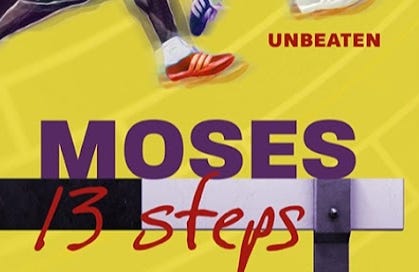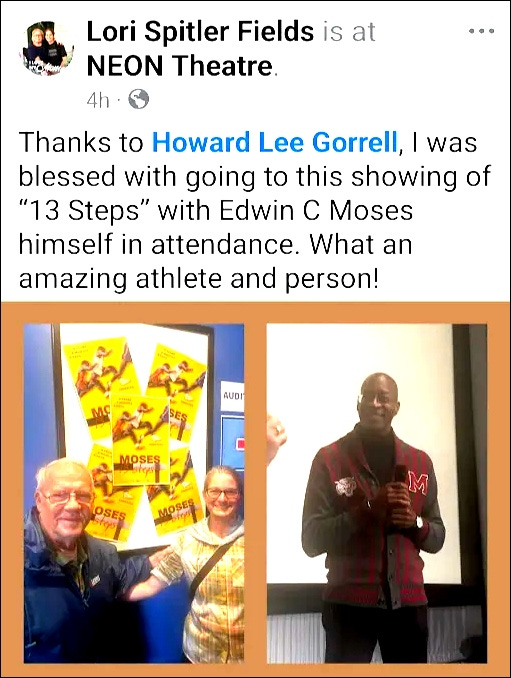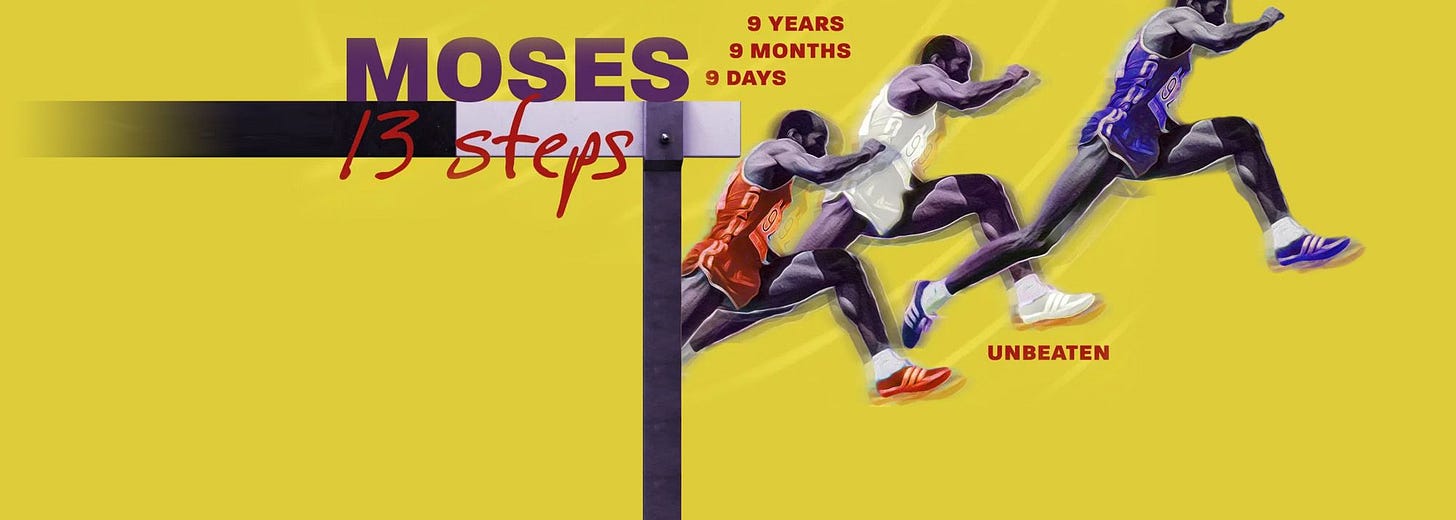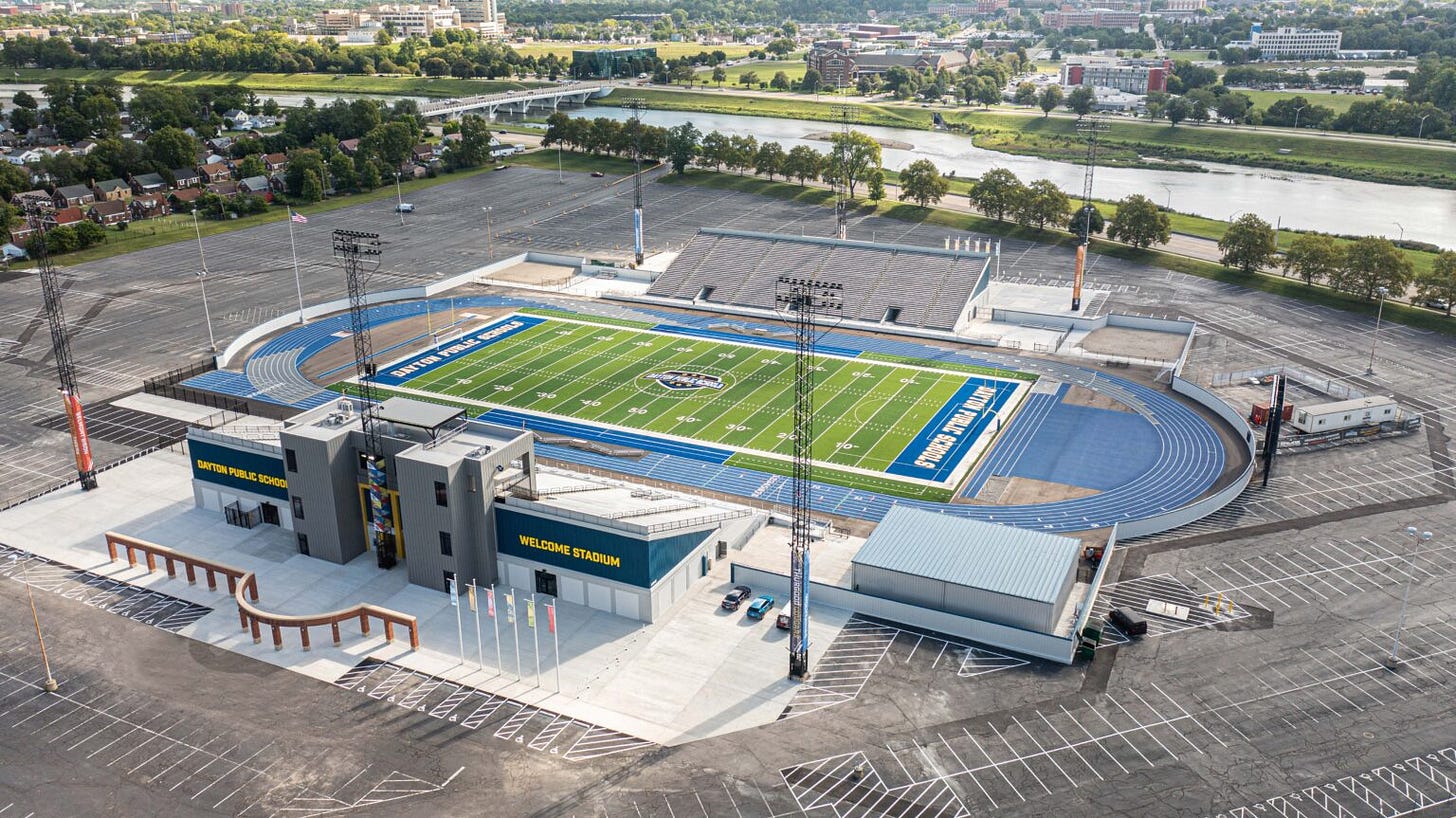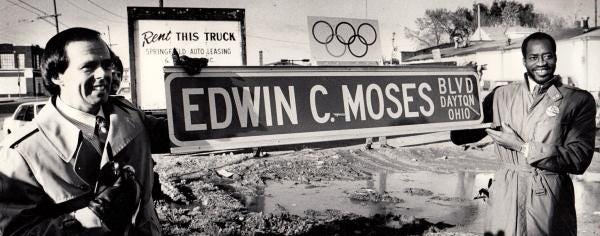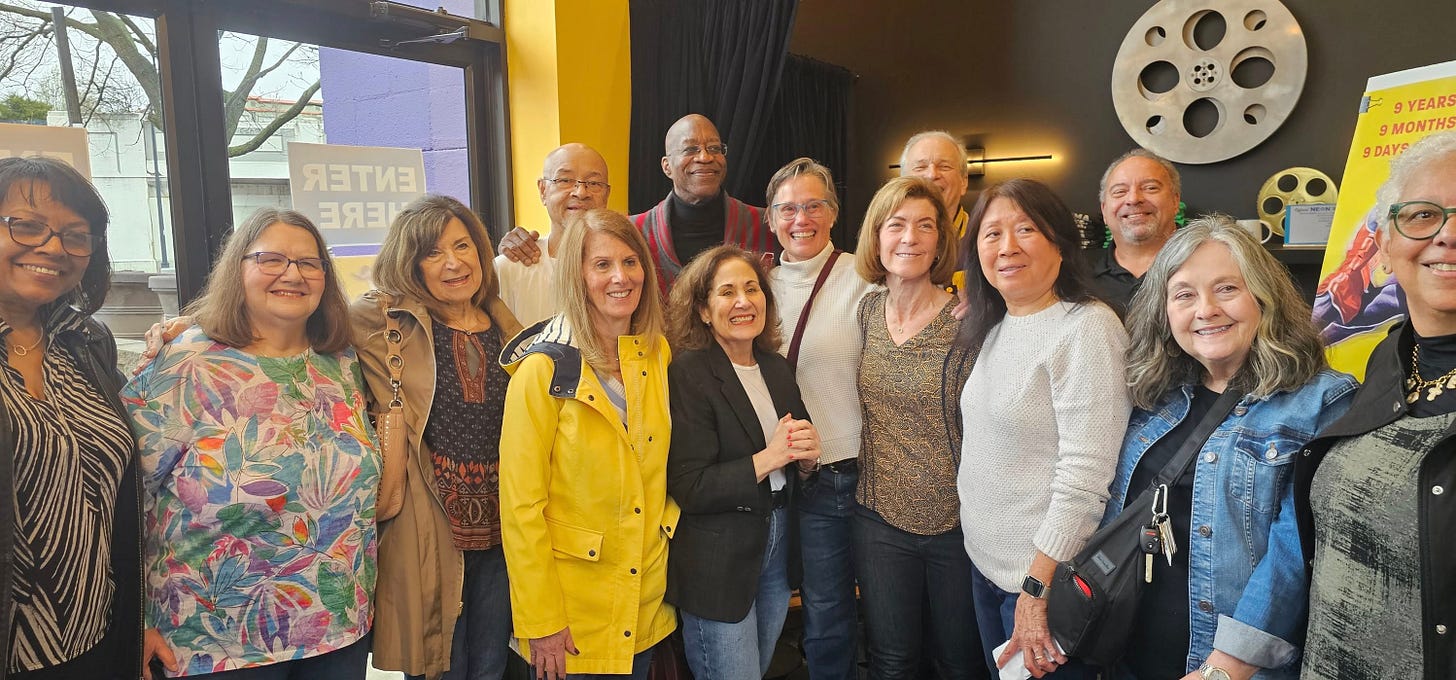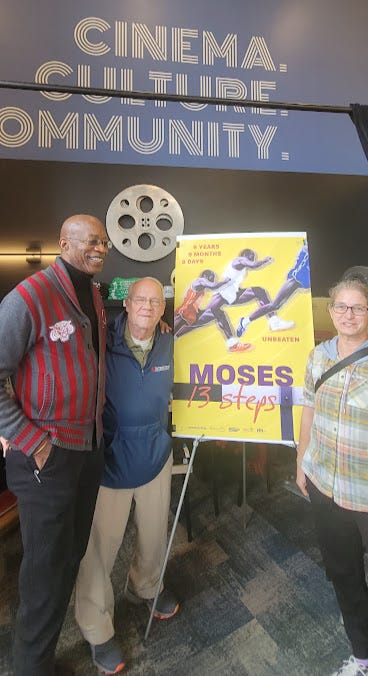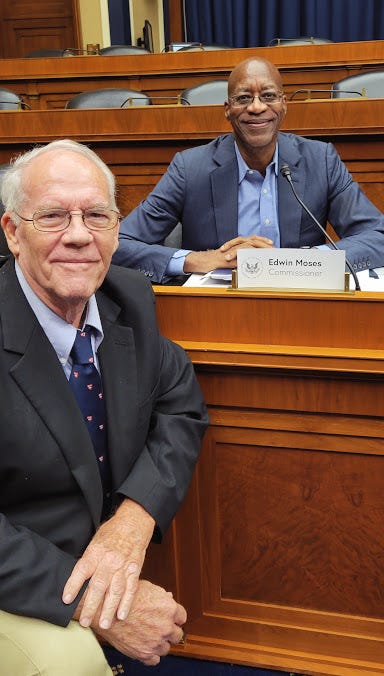On March 30, Lori Spitler Fields excitedly shared the following on her Facebook page.
As you probably know, four-time Olympian Edwin C. Moses is considered one of the greatest Olympians in history. He won 122 consecutive races in the 400-meter hurdles, set the world record twice, earned three World Cup titles, secured a World Championship gold medal, and won two Olympic gold medals.
Can you identify the first word of the T-shirt embroidery in both images below?
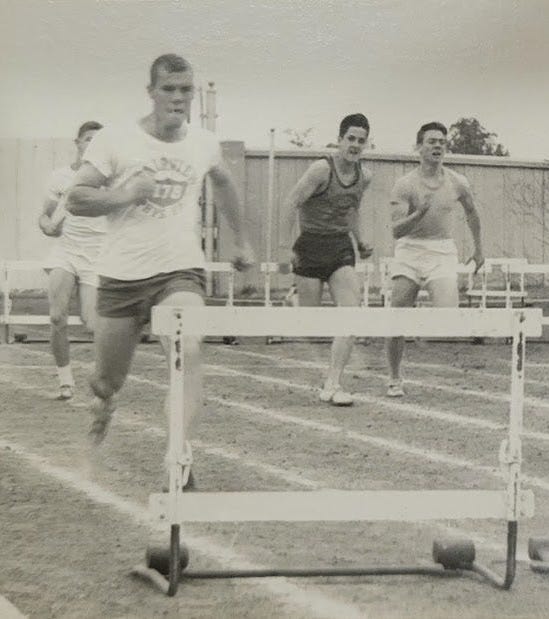
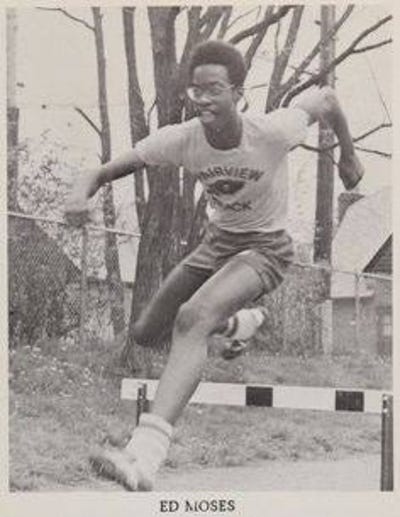
Is it the same word, Fairview? Yes, I graduated from Fairview High School in Dayton, Ohio, in 1964, and Edwin graduated in 1973.
Ironically, Moses was not a standout at Fairview in the early 1970s; he only flourished later at Morehouse College in Atlanta.
“MOSES-13 Steps” Documentary Film
'MOSES—13 Steps' tells the story of Edwin C. Moses, one of the world's most recognized and respected athletes.
The film incorporates archival footage and interviews to trace Moses’ journey from childhood through a career that features an unmatched winning streak of 122 400-meter hurdle races over 9 years, 9 months, and 9 days.
It explores how Moses blended science with athleticism to become the world’s most outstanding hurdler in the 1980s by developing his signature 13-step technique while studying physics at Morehouse College.
Watch the 'MOSES—13 Steps' trailer.
NEON Theater in Dayton, Ohio
Last February, the Fairview HS Alumni Facebook page announced that the “13-Step” would be shown in the NEON Theater in Dayton, where Edwin Moses would be present to introduce the screening, answer questions, and take pictures afterward. Suddenly, I bought two tickets. A few days later, the NEON Facebook page stated, “Both of our public screenings for MOSES - 13 STEPS have Sold Out!”
Second ticket? I always knew that no movie would be captioned at the inaugural. (No matter; I will buy a DVD so I can watch the captioned version later.) I had to find a friend in the Dayton area who knows some sign language to interpret for me.
Disappointed, my high school classmate informed me that she would be unable to attend. I snapped my fingers and recognized the other person I had first met during the Ohio University Track & Field/Cross-Country Reunion last year. I emailed her and invited her to join me to watch the film. She replied, “I am very excited!! Thank you for the invitation!! I will voice for you.” Her name is Lori Spitler Fields.
The NEON has required purchasers to select their seats. I chose two seats in the front row against the wall. My gamble paid off, as a wall speaker was just two feet away from me. The speaker allowed my smartphone to translate spoken words into text on the screen in real-time.
This was my second meeting with Lori, and I am very impressed by her exceptional athletic performance.
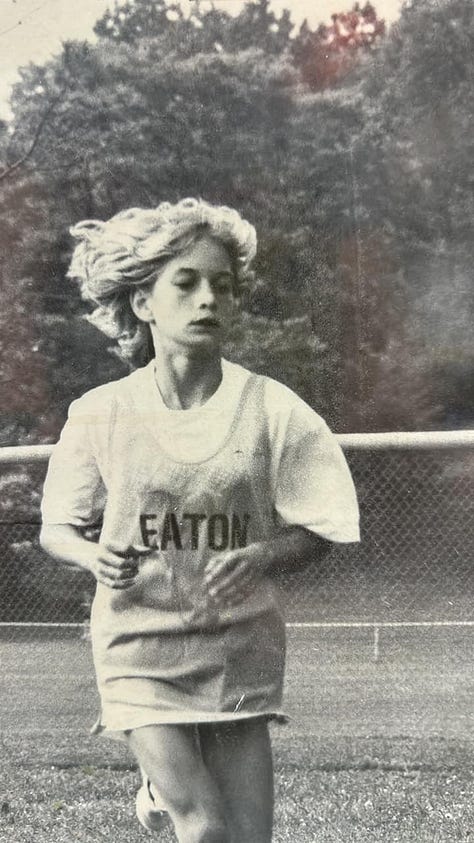

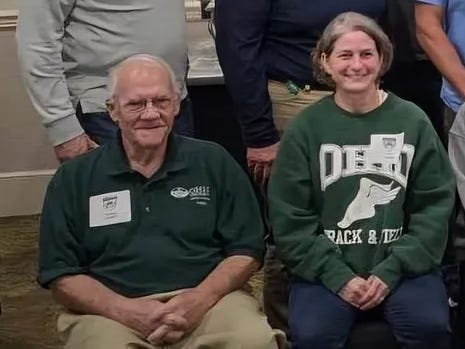
Her renowned athleticism began at Eaton High School, located 25 miles west of Fairview High, where she, standing at 5’2” and weighing 96 pounds, played on the boys’ soccer team for three years and earned a spot on the first-team All-State among girls. This coachable athlete earned four letters in track and basketball, as well as one in cross-country.
“Playing different sports breaks up the monotony. You don’t get burnt out on the same thing.” Ohio track team member and soccer player Lori Spitler on May 20, 2000.
Although Lori arrived in Ohio on a track scholarship in 1995, she also excelled in soccer. She was named to the first-team All-Mid-American Conference in soccer and set school records in both the indoor and outdoor 1,600-meter relay events. Additionally, she earned six varsity letters across three sports.
For the summer, Lori interned with the 1999 U.S. Women’s National Soccer Team, which won the World Cup at the Rose Bowl in Pasadena, California. After graduating from Ohio in 2000, she served as an assistant coach for the University of Mississippi “Ole Miss” Women’s Soccer team for three seasons.
13-step Technique Signature?
I experienced a flashback while watching the “13 Steps” film, which depicted the self-coached hurdler making a misstep on the final hurdle, ending his winning streak.
In April 1961, the Welcome Stadium hosted the Dayton Relays. As a 5’7” freshman, my high school team entered me alongside three upperclassmen hurdlers in the 120-yard shuttle hurdle event. Before this event, Fairview coach Ron Bradley and the three hurdlers informed me that if I completed my leg of the relay, I could earn a varsity letter. Unfortunately, I fell on the last hurdle and did not earn a letter in track and field.
In a 120-yard high hurdle race before the Edwin Moses era, the standard technique involved taking four to six steps between each hurdle; however, due to my shorter height, I took six steps.
I have no idea how many steps (either 4 or 6) Moses ran between the high hurdles at Welcome Stadium, where he won the 120-yard high hurdle event in the 1973 Dayton Relays during his senior year. (Please keep in mind that Moses and I practiced on the terrible 300-yard cinder-covered track beside our high school building.)
A common technique in the 440-yard high hurdle race before the Moses era involved taking 14 to 16 steps between hurdles.
Here is an excerpt from the 2023 World Athletics article - “‘Moses – 13 Steps’ - balancing power on and off the track.”
The maths between the hurdles
In 1976, Moses, a physics major from Atlanta’s Morehouse College, became the first athlete to consistently maintain a 13-step stride pattern between the 10 hurdles of the race, which became his technical signature.
Reducing the number of steps was a trend during the 20th century. 1952 Olympic champion Charles Moore pioneered the 13-step plan, but only to the fifth hurdle. Moses fulfilled the ambition of another former world record-holder, Soviet Yuriy Lituyev, who had attempted 13 steps all the way in the semifinals of the 1954 European Championships but only managed it to the penultimate hurdle and injured his hamstring in the process.
That was in the cinder track era, but with bouncier synthetic surfaces becoming standard, the 13-step approach for five or six hurdles became common in the 1970s, until the tall and long-legged Moses succeeded in applying the 13-step plan throughout.
The benefit was that Moses didn’t need to alternate his lead leg. The drawback was that this plan didn’t account for the inevitable reduction in step length as fatigue set in, posing a tricky equation for the physicist: how to fit his natural 2.70m stride – which shrinks to 2.30m as he tires – into a consistent 2.40m length between the 10 hurdles of the lap, as required by the 13-step plan?
Today, high school hurdlers can choose to take either 3 or 5 steps in the 120-yard high hurdle event. (Sadly, my favorite hurdle event, the 180-yard low hurdle [shown in the second picture above], was discontinued in regular high school competition in 1974.)
Welcome Stadium
Many nationally recognized athletes began their careers at Welcome Stadium in Dayton, Ohio.
Participating in the Olympics are Edwin Moses, Tonja Buford-Bailey, Joe Greene, Sam Hall, Lucinda Williams Adams, LaVonna Martin, and Holley Mangold. Rising in the National Football League are Keith Byars, Chris Borland, John Henderson, Drake Garrett, Javon Ringe, and Adam Trautman. Others include the NBA’s Ron Harper (soccer at Welcome), MLB’s Mike Schmidt (football), actor Martin Sheen (football), and Bobby Martin (football), the recipient of the 2006 ESPY Award from ESPN for Best Male Athlete with a Disability.
Of course, Lori and I often competed in this stadium.
Built in 1949, the 11,000-seat stadium was named after Percival Welcome, a former athletic director of Dayton Public Schools, and was originally used for Dayton High School football games. However, in 1974, it also became the home of the University of Dayton Flyers football team.
In 1984, the "Dayton Relays" became the "Edwin C. Moses Relays." The 65th edition is scheduled for May 3, 2025.
In the same year (1984), Miami Boulevard and Sunrise Avenue, adjacent to the Welcome Stadium, were renamed Edwin C. Moses Boulevard.
Posing with Edwin Moses
Before viewing, Moses posed with his high school schoolmates from his time in school (above). After viewing, Moses asked Lori and me to pose with him (below).
If you want to learn more about Edwin Moses, click on the Team Up Together article.
NOTE: This was my fourth meeting with Moses. The first meeting took place at the Athletics Congress (TAC) convention in 1980 in Atlanta, GA, which was renamed USA Track & Field (USATF) in 1992. The second occurred during a “Salute to Area Olympians” at the Carillon Historical Park in Dayton in 2004. The third was the public hearing of the Commission on the State of U.S. Olympics and Paralympics (CSUSOP) in Washington, DC, in 2023 (below). Moses is one of the 14 CSUSOP commissioners.

